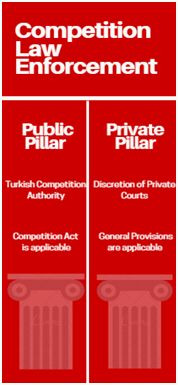
The competition law enforcement in Turkey is based on private and public enforcement pillars. Turkish Competition Authority (TCA) has sole discretion to enforce the Competition Act whereas the litigations initiated by the victims of anti-competitive conduct are seen in private courts. The Competition Act in Turkey which was enacted in 1994 contains certain provisions concerning the damages claims to be made by the victims of the violations of anti-competitive conduct (e.g. treble damages) and the general provisions of the Law of Obligations concerning tort are also applicable in that respect.
Main problems and legal developments to date
Although the TCA has been enforcing the Competition Act for over 20 years and had issued numerous violation decisions, only a very few individual litigations were initiated up until now. The reasons why the private enforcement pillar was much weaker compared to the public enforcement pillar are twofold. First, the rules concerning the statute of limitations are widely unclear and the precedents of the Turkish Court of Cassation requires that the infringement decisions of the TCA are finalized via due judicial review (or after the period for an action for annulment lapses), which takes approximately 5 years. Second there is a serious incentive problem due to the absence of an effective collective redress mechanism (i.e. a class action that would allow the claimants to claim damage compensation).

In some recent decisions, the Assembly of Civil Chambers of the Turkish Court of Cassation has solved the "statute of limitations problem" and held that the 8-year period mentioned in the Misdemeanours Act shall be applicable for damages claims related with the violation of the Competition Act rather than the 2-year period foreseen in the Law of Obligations. The legal basis of this holding is the Article 72 of the Law of Obligations which stipulates that in case the criminal laws foresee a longer period for tortious conducts that also constitute a crime (or a misdemeanour according to the interpretation of the Assembly), this longer period shall also be applied in private law.
With respect to the "finalization problem", decisions of the various chambers of the Turkish Court of Cassation made it clear that the courts must wait until the decisions of the TCA are finalized and that the judicial review process constitutes a "preliminary issue" in terms of Turkish law. However, this does not mean that the victims must wait until the finalization of the TCA's infringement decision to initiate litigations (and thus risk being barred by the statute of limitations). Turkish Court of Cassation also made it very clear that the finalization of the TCA decision is not a "prerequisite" for initiating a litigation and the courts may not refuse to examine the claims on the procedural ground that the mandatory prerequisites are not satisfied. To recap, the finalization problem does not prevent, but greatly delays the competition law based damages claims and is still a major source of inefficiency.
Although the second issue is yet to be resolved, the "Banking Decision" of the TCA condemning an anti-competitive agreement between 12 major banks in Turkey to collectively determine the interest rates for certain loans, attracted massive attention in the media and significantly raised public interest in competition law based damages claims. Due to this increased demand for such claims, a huge number of individual litigations have been initiated for the same violation in various courts in different cities of Turkey (courts in different cities have jurisdiction in tort cases per the Civil Procedure Act).
Along with these developments, it is realized that, as the second issue remains unsolved, the increased significance of the private law pillar is not just an opportunity but also a threat.
Currently, in the absence of an efficient collective redress mechanism, all these individual claims concerning the same violation are litigated separately. This means that the courts should request (and afterwards probably rely on) different expert reports, the preparation of which demands extensive resources (e.g. data, time and expertise) and this could lead to huge inefficiencies due to the multiplication of expenses. Other than that, the judicial costs and the legal expenses of the undertakings would also multiply as many courts would spend resources over the same issues and the undertakings would have to incur immense legal costs for simultaneously following a vast amount of cases.

We should add that the current laws which only require the losing party to compensate a certain portion of other parties' legal costs paves the way for abusive litigation. It might be more appropriate to require the losing party to compensate all the legal costs of the other party especially in case of collective redress.
Quantification of harm and treble damages
For now, there are no precedents or established practices concerning the calculation of damages. Assuming the experts would probably rely on the European Commission's Practical Guide for Quantification of Harm (as there seems to be no other alternative), it seems very likely that all the expert reports would include counterfactual scenarios. Since there are many different methods for the determination of counterfactual scenarios, all of which require a significant amount of assumptions and involvement of economists experienced in industrial economics, it is almost certain that the counterfactual scenarios in different cases will not be identical although they are built to determine the same market conditions (i.e. the Turkish banking market during the period of the infringement). As the counterfactual scenarios relied on would ultimately determine the amount of compensation to be awarded, it would be inevitable for the courts to award (significantly) different amounts of compensation for the same damages incurred.
This discrepancy could also be exacerbated because the courts have absolute discretion to award "treble damages" in competition law based damages claims per the Article 58/2 of the Competition Act and this means that some litigants would receive much higher compensations than the actual harm the suffered (which conflicts the basic principles of Turkish tort law and is against the EU Directive on competition law based damages) whereas the others would not. The legal uncertainties and excessive costs that arise due to the absence of an efficient legal framework is also alarmingly dangerous for the undertakings that are the defendants in these litigations.
Identification of the "victims"
Other than these, there is also a problem with respect to the identification of the "victims" that have the right to initiate damages claims. In the United States, the "antitrust injury doctrine" and more importantly the "indirect purchaser rule" are useful tools to limit the number of potential victims of an anti-competitive action who may initiate litigations. Yet, the Turkish Competition Act does not contain any special provisions in that respect and it is very difficult (if not impossible) to argue that the general principles of Law of Obligations might be interpreted in a way that would allow the judges to adopt those tools. Although the problems associated with the absence of such tools are not yet realized since the current debates are largely influenced by the immediate threat posed by the Banking Decision, there is also a pressing need to resolve this issue as fast as possible.
In summary...
The Banking Decision seems to be the fuel for the private competition law enforcement pillar that had been a very scary "stick" that only acted as a tool to "fear up" the undertakings and was never actually used. Although these new litigations are definitely a strong signal about the effects of private enforcement mechanism, the threats posed by the current system must also not be ignored.
It is crucial for the policy makers to understand that the current system that lacks clear procedural rules concerning the statute of limitations, the relation between the TCA decisions and the damages claims made in private courts and most importantly a well-functioning collective redress mechanism falls way short of being efficient. Absence of substantive rules for identifying (and limiting the scope of) the victims that may claim compensation and lack of precedents and guides for calculation of damages are also significant defects. The potential negative impacts of these issues are further exacerbated by the institution of "treble damages" which is completely alien to the Turkish legal framework and is not required (for deterrence) in the presence of a well-established public enforcement pillar (which is sufficiently deterrent by itself).
If these problems are ignored or set aside for being "too complicated to be solved" (as some claim when discussing the pressing need for a collective redress mechanism), the increased amount of litigations may become a curse rather than being a blessing soon.
The content of this article is intended to provide a general guide to the subject matter. Specialist advice should be sought about your specific circumstances.


